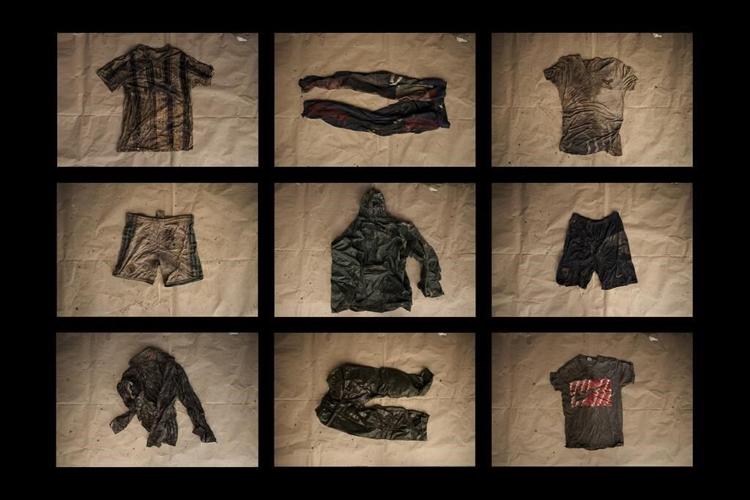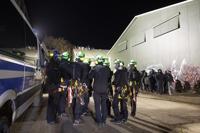BELLE GARDEN, Tobago (AP) — Around 6:30 a.m. on May 28, 2021, off the beach near the Caribbean island of Tobago, a narrow white-and-blue boat drifted onto the horizon.
From a distance, it seemed no one was aboard. But as fishermen approached, they smelled death. Then they saw the decomposing bodies of more than a dozen Black men.
What is clear now, but was not then, is this: 135 days earlier, 43 people were believed to have left a port city across the ocean in Mauritania. They were trying to reach Spain’s Canary Islands.
Instead, they ended up here, on the other side of the Atlantic.
At least seven boats carrying dead bodies appearing to be from Northwest Africa washed up in the Caribbean and in Brazil in 2021. These “ghost boats” — and likely many others that have vanished — are in part an unintended result of years of efforts and billions of dollars spent by Europe to stop crossings on the Mediterranean Sea.
That crackdown helped push migrants to return to the far longer, more obscure and more dangerous Atlantic route to Europe via the Canaries instead. Arrivals on that route jumped eightfold from 2019 to more than 22,000 in 2021, with conservative estimates for the dead and missing that year ranging from 1,109 to more than 4,000.
These migrants are as invisible in death as they were in life. But even ghosts have families.
The AP spent two years putting together puzzle pieces, including dozens of interviews, documents and DNA testing, to identify 33 of the migrants on the Mauritanian boat by name. This is the story of one.
After the boat was towed to shore, workers retrieved 14 bodies, three skulls and other large bones, clothing, 1,000 West African CFA francs (under $2) and scattered euros, and half a dozen corroded cell phones with SIM cards from Mali and Mauritania.
In 20 years as a forensic pathologist, Dr. Eslyn McDonald-Burris had never seen so many bodies arrive at the local mortuary in Tobago at once. Their apparent African descent reminded her of her enslaved ancestors.
“It’s kind of emotional for me, because I’m thinking why? What is happening here?” asked the soft-spoken Burris, who has since retired. “It’s the same currents that they used when they brought us here.”
As Burris pulled back the layers of clothing, she found soccer jerseys and shorts with insignia from Europe and Mauritania. One man was dressed more formally, wearing a black button-down shirt with thin white stripes.
Thousands of miles away, in the French city of Orléans, May Sow had all but given up hope of finding her nephew alive.
It was mid-January 2021, and Alassane Sow, 30, wasn’t answering his phone, leaving his family in both Mali and France desperate. A few days earlier, Alassane had told her over the phone that he was thinking of boarding a boat to Spain and, ultimately, to France to work. Smugglers charged 1,500 euros, and he had saved some money working as a security guard in Mauritania.
“It’s suicide,” she warned him. Even if he made it, she told him, he wouldn’t be allowed to work legally in France.
Alassane wouldn’t hear of it. After all, his French family had a good life with stable careers that allowed them to send money back to Mali to support his mother.
On the night between Jan. 12 and 13, 2021, he boarded a pirogue in Nouadhibou, Mauritania, headed to Spain’s Canary Islands, his family learned later.
After the initial silence came rumors, including one that his boat had been stopped in Morocco and the migrants sent to prison. May contacted a Malian community representative in Morocco to check prisons and morgues. No trace of Alassane.
She reached out to a page on Facebook called “Protect Migrants not Borders,” used by families of missing migrants to exchange information. That was when May realized her nephew was one of thousands disappearing each year en route to Europe.
Every day people posted about a missing person. Few were ever found. Any tips she obtained were by word of mouth. There was no official information. She felt helpless.
Alassane’s mother, grandmother and wife held onto hope that he was alive, probably in prison somewhere, and couldn’t call. May was growing increasingly skeptical.
One night, she had a dream. She saw him dead with many people in the water, and she cried out for him. In her nightmare, Alassane eventually opened his eyes but couldn’t speak. After that, she was sure they had shipwrecked. But she had no proof.
A few months later, her sister shared a news report about a Mauritanian boat found in Tobago with dead bodies inside. Then an AP reporter contacted her asking about the same. Could her nephew be among those?
The contact list extracted from one of the SIM cards on a phone in the boat by authorities in Tobago contained 137 names. The AP went down the list, and shared photos of the evidence collected in Tobago with families of the missing in Mauritania, Mali, Senegal and France.
May Sow, the aunt in France, stared at the photos on her phone for days. One looked familiar: a black striped button-down shirt. She went back to photos of her nephew from shortly before he disappeared. There it was — the same black striped shirt. He wore it on special occasions.
“I don’t think they had the right to bring things with them, so he must have worn his best clothes,” she said.
A friend of Alassane’s, who had accompanied him on the first part of the journey, confirmed that he had worn the striped shirt underneath a jacket with red pockets. Both were found on one of the bodies.
Sow reached out to the Red Cross in Senegal for help with a DNA test to confirm. But because Alassane’s mother was from Mali, they couldn’t help. So in late June, the AP got a saliva sample sent from Alassane’s mother to the Forensics Science Center in Trinidad and Tobago.
Three months later, on Oct. 4, 2022, an email arrived in May Sow’s inbox.
“I regret to inform that the DNA sample result is a positive match.”
Alassane was buried after an Islamic funeral on March 3, 2023 at the Chaguanas Public Cemetery in Trinidad and Tobago. His family, unable to travel, held prayers in both his hometown in Mali and in France.
The results of DNA testing by the Red Cross with the possible relatives of the other dead men aren’t yet known, and much of their story will likely remain unknown also. But at least May Sow knows one thing now.
“At least, for my nephew, we have proof that it is him,” she said. “We can pray for him and believe that he is in a good place.”














































